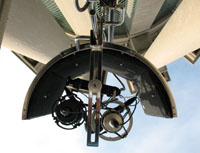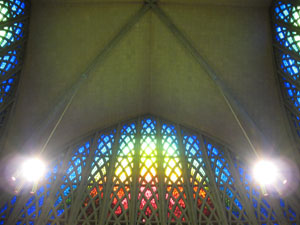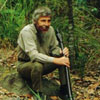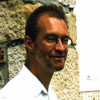ECMC25 & The Contemporary Organ Music Festival

What is the pipe organ's place in an age in which music incorporating synthesis and other forms of music technology predominates? The Contemporary Organ Music Festival, an initiative of the Eastman Department of Organ and Historical Keyboards, Eastman Computer Music Center, and College Music Department, explores the rich but little known repertoire of music for organ and tape and for organ and live electronic design. International guest composers convene in workshops and symposia to discuss the state of contemporary music, cutting-edge music technology, and the dynamic relationship between composer and performer in works with live electronics. A scientist engages with a composer in the dialogue between organ, live processing software, Renaissance history, and astronomy. And the threads come together in a concert featuring the world and US premieres of new works for organ and electronics and for carillon bells and electronics. The festival is generously supported by a grant from

Wednesday, April 11, 8:30 pm in the ECMC Studios (ESM 51)
As NEAR as possible: Contemporary music from the Netherlands between 'concrète' and 'concepts'
René Uijlenhoet, guest composer
Thursday, April 12, 5:00 pm in the ECMC Studios (ESM 51)
Live Performance Techniques using Kyma
Steve Everett, guest composer
Friday, April 13, 4:00 pm in ESM 305
[ Symposium ] The Dynamic Relationship Between Composer and Performer in Works with Live Electronics
Steve Everett and René Uijlenhoet, guest composers
Saturday, April 14, 4:00 pm in Interfaith Chapel (Wilson Blvd.), University of Rochester
Pre-concert discussion: A Dialogue with Galileo
David Douglass, Professor of Physics, and René Uijlenhoet, guest composer
Galileo Galilei's book Dialogo di Galileo Galilei ... : doue ne i congressi di quattro giornate si discorre sopra i due massimi sistemi del mondo tolemaico e copernicano proponendo indeterminatamente le ragioni filosofiche e naturali tanto per l'vna, quanto per l'altra parte (1632) compares the prevailing concept of a flat earth with Galileo's own theory of a spherical, rotating planet. Interestingly, he both defends and criticizes each model in order to evade the church's stringent censorship. Uijlenhoet will discuss how he drew technical and musical inspiration for his composition Dialogo sopra I due sistemi (2003) for organ and live electronics from the book, and Dr. Douglass will examine the book's historical context and impact across scientific, philosophical, and musical thought.
Electroacoustic Organ and Carillon Concert
Saturday, April 14, 5 - 8 pm in Interfaith Chapel (Wilson Blvd.), University of Rochester
Steve Everett, René Uijlenhoet, Ron Nagorcka, Randy Harlow, Nicole Marane, Ruth Draper, Tiffany Ng, Bogna McGarrigle, Naomi Gregory

Students from the Eastman Organ Department present a concert of electroacoustic organ and carillon works with guest composers Steve Everett (Emory Univeristy), René Uijlenhoet (the Netherlands), and Ron Nagorcka (Australia) as active performers in their pieces. The concert includes the US premiere of Uijlenhoet's Dialogo sopra I due sistemi (2003) and the world premieres of Paul Coleman's Tiffany Sketches for carillon and amplified electronics and Wojciech Kalamarz's Les Pensées d'Olivier for organ and CD. At intermission, attendees will enjoy a dinner reception with the composers and performers, followed by a light closing reception after the concert.

Steve Everett is Professor of
Music and teaches composition, computer music, and directs the Music-Audio Research Center at Emory University.
Many of his recent compositions involve performers with computer-controlled electronics and have been performed
in seventeen different countries throughout Europe, Asia, and North America, including at IRCAM and INA-GRM
Radio France in Paris, the Lincoln Center, and Carnegie Hall. The recipient of composition awards from the
Rockefeller Foundation, Asian Cultural Council, Chamber Music America, American Composers Forum, and
International Trumpet Guild, he is recorded on SCI, Crystal, Mark, Frog Peak and ACA Digital Records.
He was a resident research fellow at the Rockefeller Study Center in Bellagio, Italy, Liguria Foundation
in Bogliasco, Italy, and at the Center for Humanistic Inquiry at Emory University. In addition to substantial
experience conducting opera and orchestral repertoire, he has presented over 200 works of contemporary
music as conductor of Thamyris New Music Ensemble in Atlanta since 1992. He earned his doctoral degree in
composition from the University of Illinois studying with Salvatore Martirano. He also studied composition
with Sir Peter Maxwell Davies and Witold Lutoslawski at Dartington Hall in England and has received
foundation support for study in Bali, Java, and India. He served as chair of the Department of Music
and interim director of the Center for Humanistic Inquiry at Emory University.

Composer, performer, and naturalist Ron Nagorcka spent much of his childhood exploring music and the natural world on a sheep farm in Western Victoria, Australia. He went on to study pipe organ with Sergio de Pieri, harpsichord with Max Cooke, and composition with Keith Humble, Ian Bonighton, and Jean-Charles Francois at Melbourne University and then composition and electronic music at the University of California San Diego. During the 1970's, he founded the Clifton Hill Community Music Centre in Melbourne. He has toured Europe, the USA, and Japan as a composer and performer. Since 1988, he has been living and working in a remote forest in northern Tasmania, where he built a house and solar-powered studio. As an active field naturalist, he takes a keen interest in the science and aesthetics of the Australian bush and has produced a comprehensive identification CD for Tasmanian birds with David Stewart of "Naturesound Australia." His recordings of nature become the basis for many of his compositions. The melodies, rhythms, even the instrumental quality of the music are generated by painstaking analysis of natural Australian soundscapes. Digital technology also enables him to explore the ancient tuning known as "just intonation." An analysis of birdsong provides the basis for the scales he designs. He makes and plays his own didjeridus and regularly incorporates this instrument into his music. The influence of traditional Aboriginal music is otherwise most evident in his rhythmical techniques. From 1990-1996, much of his output was performed by the ensemble NYET, a collaboration with Tasmanian poet Bruce Roberts. In 1996, with a grant from the Australia Council, NYET was joined by artists inspired by Tasmania's natural heritage in a series of public workshops and concerts in national parks and remote areas of northern Tasmania.

René Uijlenhoet studied electroacoustic composition under Ton Bruynèl at the Utrecht Conservatory, where he also earned diplomas in organ and improvisation. From 1988 to 1990, he lectured in electroacoustic composition at the Utrecht Conservatory, and from 1990 to 1994 he conducted classes in computer composition at the Department of Musical Technologies at the Utrecht School of the Arts. From 1996 to 1998, he directed NEAR, the Dutch Centre of Electro-acoustic Repertoire, run by the Gaudeamus and Donemus foundations. He taught electronic composition at the Rotterdam Conservatory from 1997 to 2006. Uijlenhoet's works include compositions combining traditional instruments with tape or live electronics, as well as works only for tape, live electronics, and ballet and theatre music. In 1993, his open-air work Zware Metalen for carillon, electric bells, and amplified electronic sounds represented the Netherlands in the Prix Italia competition. He built the live electronics installation Wired Life for the 'De IJsbreker' hall, and it played from 1998 to 2000 in the Gemeentemuseum in The Hague. In 1998, with artist Nora Hooijer, he presented De Muis met het Oor, a multimedia live electronics/live painting based on the electronic music theories of the painter Piet Mondrian in the Stedelijk Museum in Amsterdam. The 1999 Rotterdam Music Biennale presented his work Lichtgewicht on four-channel tape. In 2000, he composed Vorst aan de Grond for carillon, electric bells, and tape and in 2003 Koraalriff for organ, live electronics, and tape. In 1994, his electronic composition Wedge won the first prize at the Bourges Quadrivium Competition (France) and Lichtgewicht reached the final round of the Bourges International Competition in 2000.
[ Last updated April 9, 2007. ]
